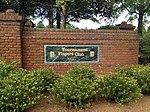Purefoy–Dunn Plantation
Buildings and structures in Wake County, North CarolinaFarms on the National Register of Historic Places in North CarolinaHistoric districts on the National Register of Historic Places in North CarolinaHouses completed in 1850National Register of Historic Places in Wake County, North Carolina ... and 2 more
Plantation houses in North CarolinaUse mdy dates from August 2023
Purefoy–Dunn Plantation is a historic plantation and national historic district located near Wake Forest, Wake County, North Carolina. The Greek Revival style plantation house was built about 1814 and remodeled about 1850. It is a two-story, L-shaped, heavy timber frame building. It has a low hipped roof and is sheathed in clapboards. The front portico was removed in the 1960s or early 1970s. Also on the property is a contributing mid-19th century gable-roofed frame smokehouse.
Excerpt from the Wikipedia article Purefoy–Dunn Plantation (License: CC BY-SA 3.0, Authors).Purefoy–Dunn Plantation
Caveness Farms Avenue, Wake Forest
Geographical coordinates (GPS) Address Nearby Places Show on map
Geographical coordinates (GPS)
| Latitude | Longitude |
|---|---|
| N 35.958888888889 ° | E -78.538611111111 ° |
Address
Caveness Farms Avenue
Caveness Farms Avenue
27587 Wake Forest
North Carolina, United States
Open on Google Maps





